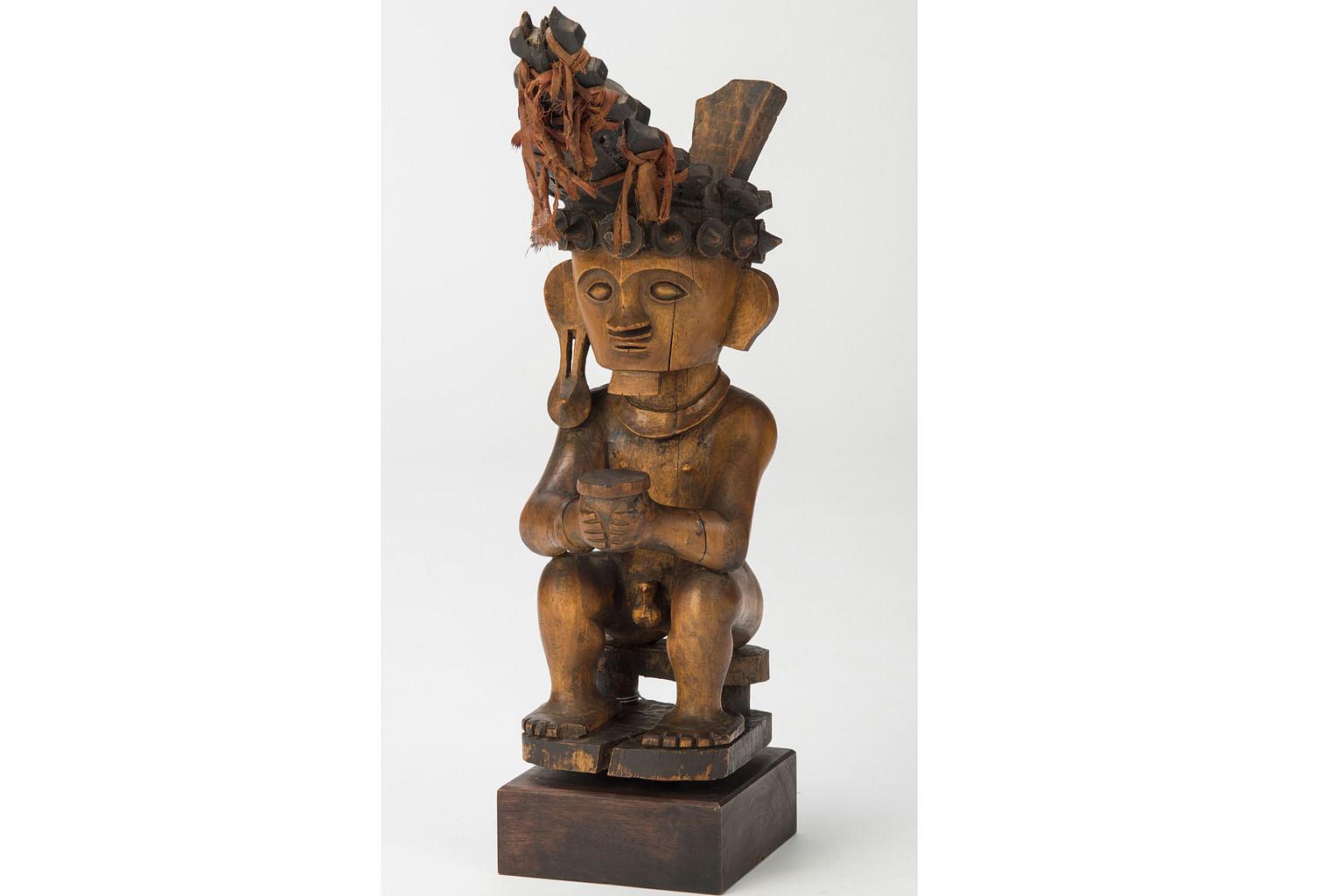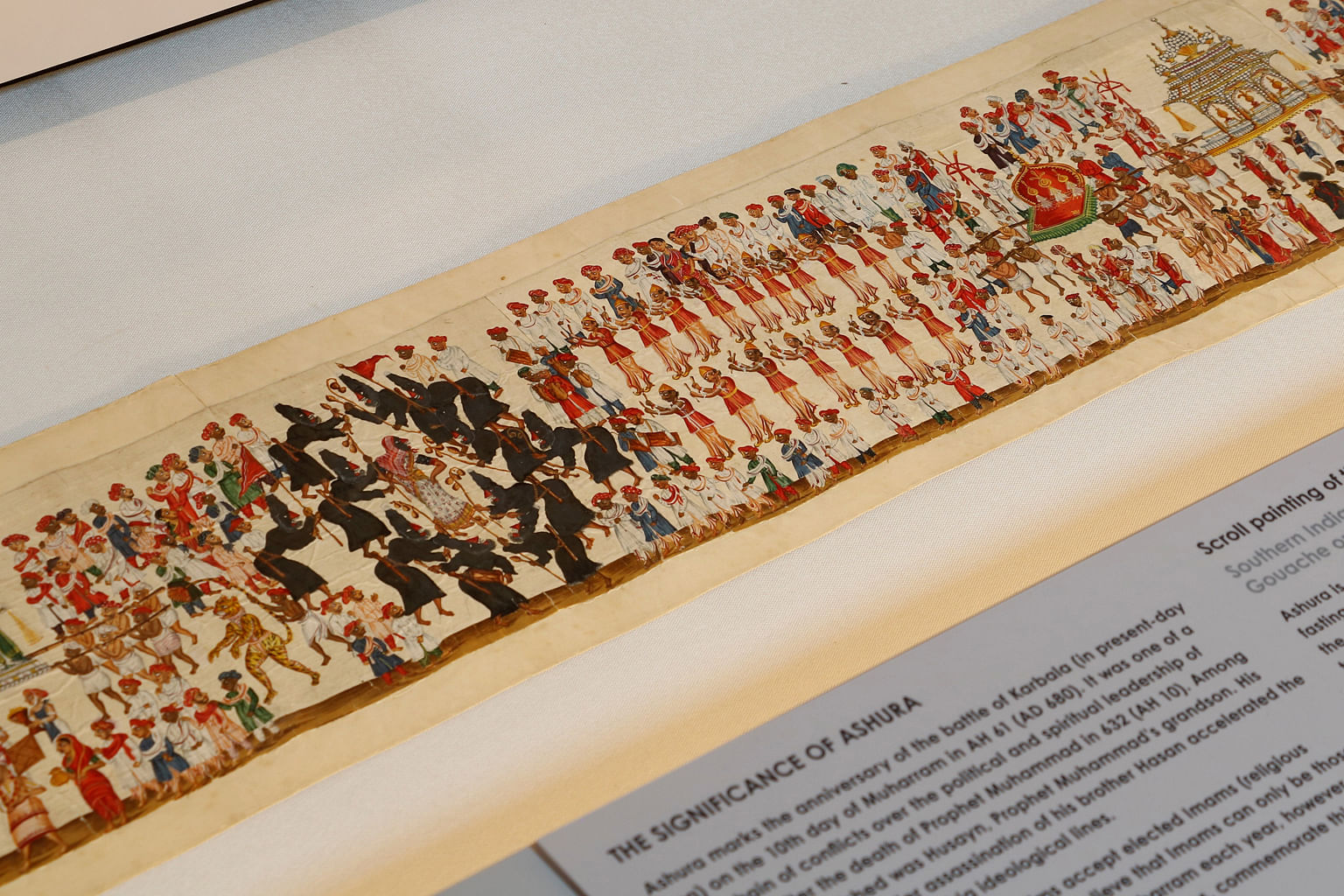Here are some highlights from the new galleries at the Asian Civilisations Museum
Ancestors and Rituals gallery
Warrior's headdress
The Ilongot people of the Philippines would have bestowed this headdress on a warrior who was successful at headhunting, the practice of taking and preserving heads after killing people.
While this 19th-century piece is adorned with a monkey's skull, hornbill casques - decorative growths on the top of the bird's bills - were more commonly used.
This headdress, also made of rattan, gold, metal and cloth, comes from the Nueva Vizcaya province in the Cagayan Valley of north-eastern Luzon.

Ancestor figure
This is a wooden figure of the founder - or most ancient ancestor - of a village in Indonesia's Nias Island. These figures, known as siraha salawa, show the ancestor sitting or squatting while holding a cup. Another key feature is a large pointed crown, decorated here with red ribbons in this 19th-century piece.
People made sacrificial offerings to the siraha salawa to secure protection for the household. Before Christianity took hold on the island in the early 20th century, every home would have had one such large ancestor figure, usually passed down from previous generations.

Shield
This 19th-century shield from the Iban tribe, a branch of the Dayak peoples in Borneo, is said to protect its bearer in more ways than one: the handle at the back, carved to resemble an ancestor warrior, serves as a powerful protective symbol.
The front of the shield is also heavy with symbolism, with motifs such as auspicious animals and the scrolling Tree of Life. A hornbill at the top of the central panel symbolises the gods, while a snake at the bottom symbolises the underworld.
A human figure and crocodiles represent the earthly realms. Other auspicious animals appear at the bottom of the shield.
Islamic Art gallery Christian Art gallery

Scroll painting of the Ashura procession
This 19th-century scroll painting depicts an Ashura procession, commemorating the anniversary of the Battle of Karbala (in present-day Iraq) which took place on the 10th day of Muharram, in AD680.
The battle was part of a long chain of conflicts over the political and spiritual leadership of Muslims, dating from the death of Prophet Muhammad in AD632.
One of those who died was the Prophet's grandson Husayn, whose brother Hasan had been assassinated earlier.
This 5.7m-long scroll - gouache on paper with a cloth backing - is from South India (possibly Madras), dating to the 1830s or 1840s.
It depicts standard features of the procession, such as the ta'ziya (representations of the tombs of Hasan and Husayn), the 'alam (processional standard) and the sipar (shield) to re-enact the battle of Karbala.
But there are also some "unusual" elements, such as men dressed as demons and animals.
These carnival-esque characters could have provided entertainment and collected money to help defray the cost of the procession, says curator Noorashikin Zulkifli.

Talismanic shirt (jama')
This cotton shirt, which dates back to 16th-or early 17th-century Mughal India, is inscribed with all the surah (chapters) of the Quran.
The words are written with ink in black and red Ghubari script, within a lattice of rectangles linked with red, blue and gold concentric roundels.
Each panel contains a single verse, with surah headings in blue on the gold panel. Two large roundels on the front are inscribed with the shahada (testimony of faith) in elongated gold Bihari script, while the border of the shirt is filled with the 99 Names of Allah.
The exact use of such shirts remains unknown, although warriors are thought to have worn them underneath their armour for protection in battle.

Quran (Terengganu style)
This 19th-century Quran from Terengganu in the Malay Peninsula was probably commissioned for a royal patron and features lavish use of gold pigments and multiple decorative frames within frames.
The use of red, yellow and black was the preferred colour scheme for copies of the Quran throughout maritime South-east Asia - those from Terengganu featured the use of white and green too.
Christian Art gallery

The Virgin Mary
This ivory sculpture of the Virgin Mary bears the imprint of Asian and European cultures.
The tucks in the robe, called suksok, are features of some statues created in the Philippines in the 17th century, while the Asian features of the Virgin's face suggest the work of a Chinese artist.
This sculpture was shipped from Manila to Mexico for decorating and the painting and gilding of the robes are typical of 17th-century Mexican decorations of sculptures - the sort one might find in Mexico City.
This 60cm-tall sculpture is one of the largest known solid ivory figures from the Philippines, which suggests a prestigious commission.

Fumi-e: Pieta
In the 17th century, a time when Christianity was banned in Japan, suspected Christians were asked to step on Christian objects known as fumi-e ("pictures to trample"). Those who refused were accused of being Christian.
This practice began in Nagasaki as early as 1628.
This bronze plaque, which may have been brought to Japan as a devotional image, dates back to 17th-century Europe and shows the Virgin Mary holding the dead body of Jesus - a subject known as a pieta.
The plaque was later confiscated and attached to a block of wood to be used as a fumi-e.

Bureau shrine
While artists in Guangzhou produced exquisite pieces of lacquered furniture that were exported in the 18th and 19th centuries, this is the only bureau known to have been made as a Christian shrine. The 2.8m-tall piece, originally a bureau cabinet made in Europe, was probably converted into a lacquered bureau shrine in Guangzhou in the 1730s. It was previously owned by a Portuguese family in Macau.
The serpentine columns and framing elements are enhanced with red and gold lacquer. The figure of a crucified Christ was carved in Goa, India around 1700, while the figures of St Francis and St Anthony which flank him are replacements for the original figures.


